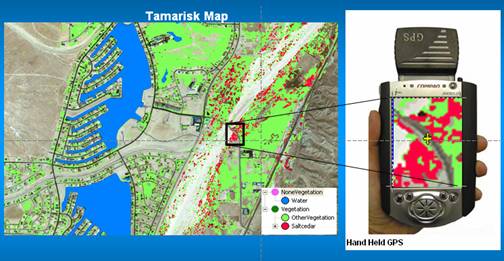Tamarisk
What is a Tamarisk Map?
The Tamarisk (Saltcedar) Map shows the spatial distribution of Tamarisk over the area of interest. The map is produced using proprietary algorithms to take advantage of the spectral, spatial and temporal attributes of remotely sensed imagery.
How can the map be used?
Tamarisk Map can be imported into a hand held GPS for field scouting and to support Tamarisk eradication programs. It can also be imported into Variable Rate Applicator in support of a controlled chemical application eradication program.
Product value
Tamarisk is an invasive species that has infested large areas, about 260 million acres in the Western US. This weed sinks its root along rivers and springs in desert climates and consumes nearly twice the water of native plants like cottonwood. In addition, it accumulates mineral salts in its leaves that, as they accumulate on the ground, create a high soil salinity zone not tolerated by adjacent native vegetation. By altering the surrounding soil environment, the plant rapidly dominates native vegetation. If Tamarisk is not eradicated there is a great chance of critically diminishing the water flow in the Colorado River.
A variety of crude, inexact and costly methods are currently in use for identifying, locating and mapping invasive weed species. The principal tools used for these purposes range from: “boots on the ground” visual surveys, aerial photography (with and without verification by visual inspection in the field); to the use of more sophisticated tools such as hand held GPS units to mark and measure the target species for incorporation into a geo-database. All these methods are expensive, labor-intensive, and limited to accessible areas. There is an urgent need for mapping noxious species to assess infestations. These digital weed maps can be used for more efficient and cost effective planning, managing, monitoring and eradication programs.
How to Request Tamarisk Map
Call GeoSpatial Partners at (303) 513 0092

|